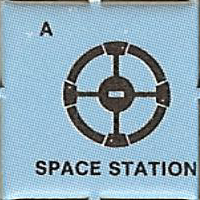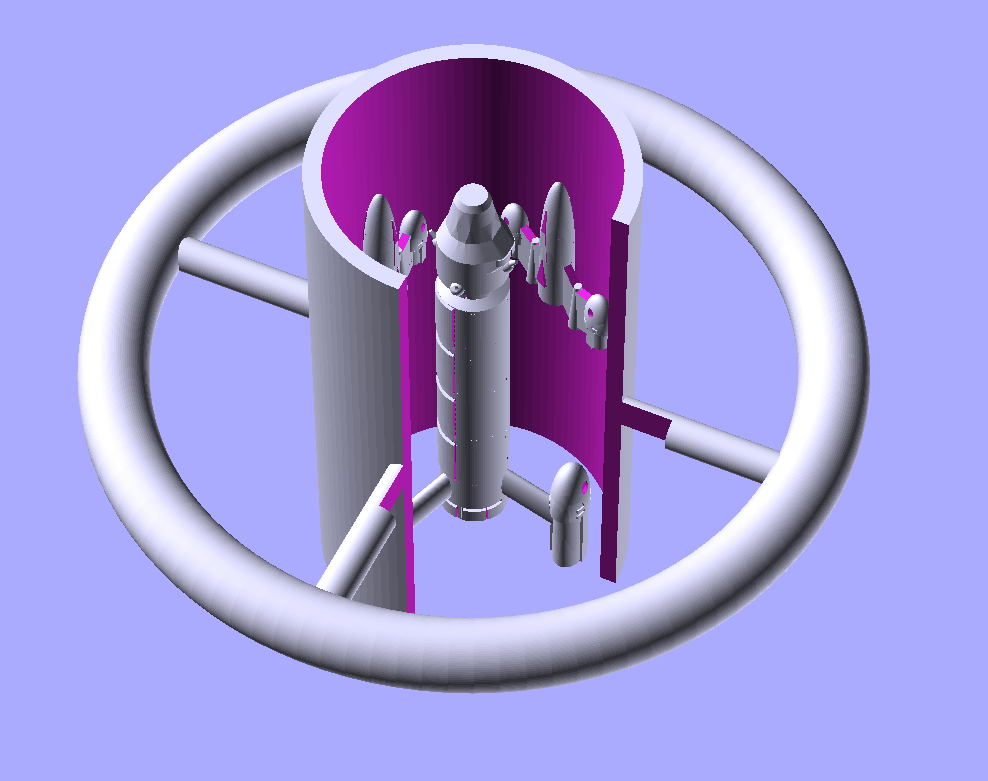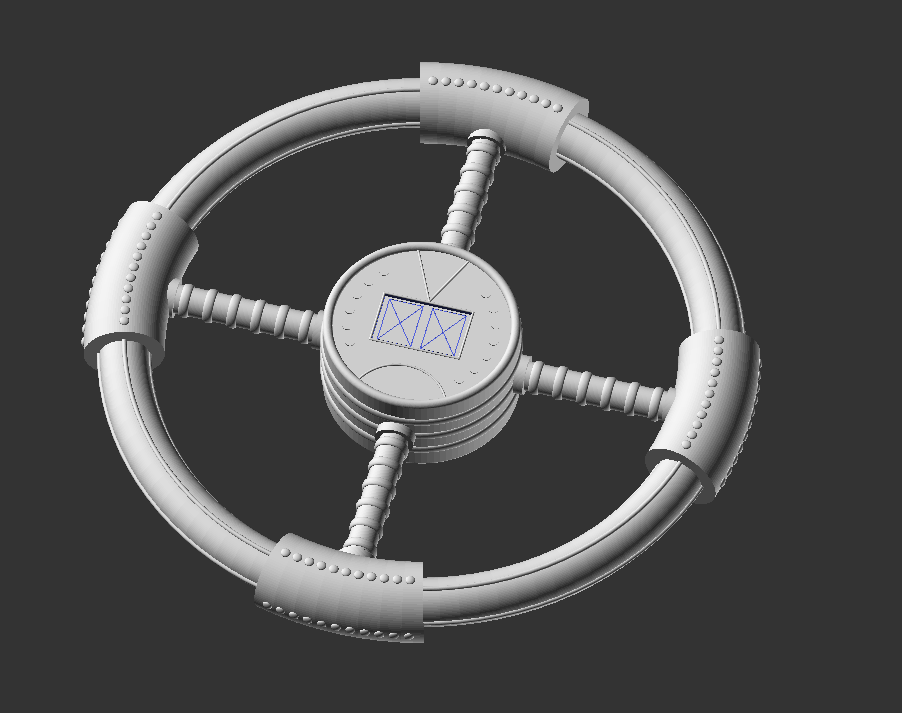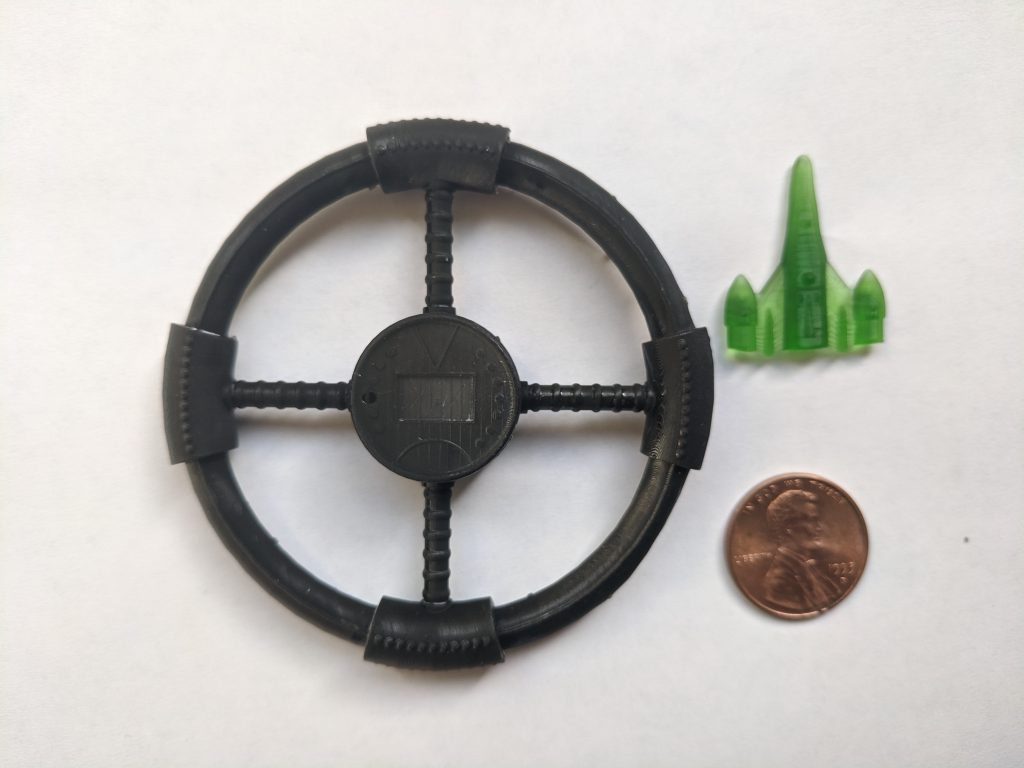I teased this model in the last State of the Frontier post where I showed a picture of the printed miniature. In this post, I’ll talk about the creation of the Armed Station model and miniature that I created as part of my current interest in doing more 3D modelling.
Scale and Sizes

The basic outline of this model is based on the space station counter that came with the Knight Hawks boxed set, pictured to the right. For scale, I assumed this to be a HS 6 station making the diameter of the station 1200 meters, just short of a mile. In the end, the model was a bit bigger than that as I set the diameter of the center of the ring to be 1200 meters but that’s a minor quibble that can be fixed if really wanted by scaling the final model.
When I do my modeling, I typically work at 1/1000 scale in the model files so 1 meter on the actual vessel is represented as 1 mm in the model. However, for the space station, that was just a little bit too bit so instead I worked at 1/10,000th scale or 1mm = 10 meters. In the end, at that scale, the model came out at 137.4mm across, or 5.4″.
With the outer ring having a diameter of 1200 meters, that gives us some dimensions of other parts of the structure using the counter image as a silhouette.
The Main Ring
First is the cross sectional size of the ring itself. I chose to model the ring, at least for this version of the model with a circular cross section. I may do a future one with a square or rectangular cross section. Regardless, at this scale, that give the ring a height of 100 meters in the radial direction. So for the model, it has a diameter of 100 meters
That means, assuming you have 5m per deck, you could put 20 separate decks in the ring of the station, with the widest deck at the center being about 100m wide and the decks getting narrower as you move up or down from the center. The upper (and lower) two or three decks would be fairly narrow and probably used for machinery and other non-public areas.
The Spokes
On this station, the spokes connecting the hub to the ring are 60 meters across. Again, I chose to use a circular cross section so they are 60 meters in diameter.
In addition to the spokes of the station, the counter shows a thicker “sheath” around the ring where the spokes meet it. This sheath is 164 meters in diameter compared to the 100 meters of the ring. That means that there can be an additional 12 decks in this section of the station.
The Hub
Let’s start with what we can see from the picture on the counter. Measuring this out, the hub is 400 meters in diameter. That is the same size as the outer diameter on a hull size 2 station! But that’s fine. This is a big station and is supposed to be able to dock a lot of ships of all sizes.
That brings us to the first constraint. According the Star Frontiers rules, a hull size 6 station can dock any sized ship, including the HS 20 ships. Those ships are 100m in diameter. So the bay opening into the hub has to be at least that big. As drawn, in the counter, it’s only 85 meters wide so we’ll have to make it a little wider but that’s not that big of an issue. I ended up modeling it 110 meters wide. A HS 20 ship will fit, but it will be tight.
The harder part is the length of the hub. Those same HS 20 ships are 600 meters long. Or equal in length to the radius of the entire station. For our hub to be able to house those ships inside as the game implies, means that the hub has to be really long, at least 650 meters (to handle variations in width/length both the door and length should probably be larger but that’s what we’re going with here.) This results in a station that looks like this.

The same is true for the smaller stations. This image is one I made a long time ago of a HS 1 station which is just 200m in diameter and supposed to be able to house up the HS 6 ship. This shows a cut away of the hub with the CDCSS Nightwind inside along with a couple of assault scouts. I didn’t put bay doors on this one, as it was just for scale comparisons.

Personally, I don’t like the hub that big and in my game, the bigger ships don’t dock inside the hub. Rather they just enter a nearby parking orbit and material and people are moved across by shuttles, which can dock in the hub. So for the final version of this model, I made the hub just 200m tall instead of 650m. That’s still big enough to dock up to a HS 8 ship inside. In a future version, I might make it a little bigger, at 250-260m allowing a HS 10 ship to dock inside. But anything else starts to look a bit to big.
Finishing up the Model
Once I’d decided on the size of the hub, the basic shape of the station was done, but it was pretty boring looking. So I decided to add a bit of surface detail to the model to make it a little more visually appealing.
First I created bay doors that I could position either open or closed. In the end I decided to print the model with them closed but I created models with them both open and closed.
Then I added some surface detail all around the ring, spokes, and hub to give it a little character. In the end, the final model looked like this.

The asymmetry in the number of pips to the left and right of the doors was accidental. But I decided to leave them. The V-shape and half moon shape above and below the bay doors where intentional as navigational markers. The side with the ‘V’ that touches the bay entry is the “up” direction to orient ships aligning with the bay for entry. the opposite side of the hub is identical.
Printing the Model
As I said earlier, the completed model, at 1/10,000th scale is 137.4 mm. The problem is my high resolution printer has a maximum width of 120 mm. So this is just a bit too big. It’s not too tall, the limit there is 155 mm. And it’s not too thick as it can be 68 mm wide and this model is only 22mm wide (that would have been a bigger issue if I’d gone with the fat hub). I could easily print it on my big printer; in fact, I could print it at 1/5000th scale if I wanted to) but that wasn’t the plan. I wanted to print it on the SLA printer. If I rotate it just right, the software says it is possible to print the station at 1/10,000 scale in the build volume I have. And I might try that one day
However, from the beginning I had planned to print it at 1/20,000th scale which makes the largest dimension just 68.7 mm or 2.7″. So that’s what I did. You can see the result in this image.

The only detail that doesn’t show up is the “X” on the bay door. They are there, but very, very faint. I might go back and thicken them up in the future so they show up better on the print.
Final Thoughts
Given the size of the station, if it is spinning such that the deck at the center of the ring has a gravity of 1.0g, then for every 60m you move toward or away from the center of the station, you gravity will change by 0.1g. This means that the upper deck, 45m above that position will have a gravity of 0.925g while the outer deck will have a gravity of 1.075g. In the part of the station where the spokes connect, assuming there are decks all the way out to the edge, you get a range from .87g to 1.13g. And the hub with a radius of 200m, has a gravity of 0.33g, roughly the equivalent of the surface of Mars.
That raises an interesting point. The docking area in the hub is supposed to be fairly low gravity. I wouldn’t consider 0.33g to be that low so the hub is probably a bit too large in diameter. But it looks cool so it’s fine for the model.
The model has already gone out to my Patreon supporters at the Surveyor ($2/month) or higher. If you join at that level you’ll get access to it as well. Anyone that joins at the Crafter level ($30/month) in the month of October will get a printed version of the model as well as 8 UPF and 8 Sathar fighters. I’m also planning on posting the UPF Light Cruiser this month (the model is almost done) so a printed mini of that model will go out to backers at that level as well. Those will all be printed and shipped out in early November.
If you don’t want to back the Patreon, but still would like to get a print of any of the miniature models I’ve created, you can jump over to the “Order Miniatures” page to see the costs for the minis and place an order.
Let me know your thoughts and comments on the Armed Station model and miniature in the comment section below.